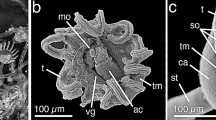Summary
Ultrastructural study of the buccal tentacles of Holothuria forskali revealed that each tentacle bears numerous apical papillae. Each papilla consists of several differentiated sensory buds.
The epidermis of the buds is composed of three cell types, i.e. mucus cells, ciliated cells, and glandular vesicular cells (GV cells). The GV cells have apical microvilli; they contain bundles of cross striated fibrillae associated with microtubules. Ciliated cells have a short non-motile cilium. Bud epidermal cells intimately contact an epineural nervous plate which is located slightly above the basement membrane of the epidermis. The epineural plate of each bud connects with the hyponeural nerve plexus of the tentacle. This nerve plexus consists of an axonic meshwork surrounded in places by sheath cells. The buccal tentacles have well-developed mesothelial muscles. Direct innervation of these muscles by the hyponeural nerve plexus was not seen.
It is suggested that the buccal tentacles of H. forskali are sensory organs. They would recognize the organically richest areas of the sediment surface through the chemosensitive abilities of their apical buds. Tentacles presumably trap particles by wedging them between their buds and papillae.
Similar content being viewed by others
References
Bertram GCL (1936) Some aspects of the breakdown of coral at Ghardaqua, Red Sea. Proc Zool Soc Lond 1936:1011–1026
Brumbaugh JH (1965) The anatomy, diet, and tentacular feeding mechanisms of the dendrochirote holothurian Cucumaria curata Cowles 1907. Ph.D. Thesis, University of Stanford, 119 pp
Cherbonnier G (1954) Le Roman des Echinodermes, SAM. Les beaux livres 128 pp
Cobb JLS (1968) The fine structure of the pedicellariae of Echinus esculentus L. II. The sensory system. J Roy Micr Soc 88:223–233
Dorsett DA, Hyde R (1969) The fine structure of the compound sense organs on the cirri of Nereis diversicolor. Z Zellforsch 97:512–527
Fankboner PV (1978) Suspension-feeding mechanisms of the armoured sea cucumber Psolus chitinoïdes Clark. J Exp Mar Biol Ecol 31:11–25
Feral JP (1980) Cuticule et bactéries associées des épidermes digestif et tégumentaire de Leptosynapta galliennei (Herepath) (Holothuroidea-Apodes). Premières données. In M Jangoux (ed), Echinoderms: Present and Past, Balkema Publ, Rotterdam, 285–290
Florey F, Cahill MA (1977) Ultrastructure of the sea urchin tube feet. Cell Tiss Res 177:195–214
Gabe M (1968) Techniques histologiques. Masson et Cie: Paris
Ganther P, Jolles G (1969–1970) Histochimie normale et pathologique vol I et II. Gauthier — Villars: Paris
Gardiner SL, Rieger RM (1980) Rudimentary cilia in muscle cells of annelids and echinoderms. Cell Tiss Res 213:247–252
Hammond LS (1982) Analysis of grain size selection by deposit-feeding holothurians and echinoids (Echinodermata) from a shallow reef lagoon, Discovery Bay, Jamaica. Mar Ecol Prog Ser 8:25–36
Hauksson E (1979) Feeding biology of Stichopus tremulus, a deposit-feeding holothurian. Sarsia 64:155–160
Holland ND, Nealson KH (1978) The fine structure of the echinoderm cuticule and the subcuticular bacteria of echinoderm. Acta Zool 59:169–185
Jangoux M (1982) Digestive system: general considerations. In Echinoderm Nutrition, M Jangoux and JM Lawrence (eds), Balkema Publ Rotterdam, 185–186
Laverack MS (1974) The structure and function of chemoreceptor cells. In Chemoreception in Marine Organisms: Grant PT and Mackie AM (eds), Academic Press London New York, 1–48
Lison L (1960) Histochime et cytochime animales. Gauthier Villars: Paris
Massin C (1980) The sediment ingested by Holothuria tubulosa Gmel (Holothuroidea: Echinodermata). In M Jangoux (ed), Echinoderms: Present and Past, Balkema Publ Rotterdam, 205–208
Massin C (1982) Food and feeding mechanisms: Holothuroidea. In: Jangoux M and Lawrence JM (eds), Echinoderm Nutrition, Balkema Publ Rotterdam, 43–55
Massin C, Jangoux M (1976) Observations écologiques sur Holothuria tubulosa, H. poli et H. forskali et comportement alimentaire de H. tubulosa. Cahiers Biol Mar 17:45–59
Menton DN, Eisen AZ (1970) The structure of the integument of the sea cucumber, Thyone briareus. J Morphol 131 (1):17–36
Nørrevang A, Wingstrand KG (1970) On the occurrence and structure of choanocyte-like cells in some echinoderms. Acta Zool 51:249–270
Oldfield SC (1975) Surface fine structure of the globiferous pedicellariae of the regular echinoid, Psammechinus miliaris Gmelin. Cell Tiss Res 162:377–385
Reynolds E (1963) The use of lead citrate at high pH as an electron opaque stain in electron microscopy. J Cell Biol 17:208–213
Roberts D (1979) Deposit-feeding mechanisms and resource partitioning in tropical holothurians. J Exp Mar Biol Ecol 37:43–56
Schulte E, Riehl R (1976) Electron microscope studies on the tentacles of Lanice conchilega (Polychaeta Sedentaria). Hegol Wiss Meeresunters 28 (2):191–205
Schulte E, Riehl R (1977) Electron microscope studies on the preoral tentacles and skin of Branchiostoma lanceolatum. Hegol Wiss Meeresunters 29 (3):337–357
Sloan N, Campbell AC (1982) Perception of food. In: Jangoux M and Lawrence JM (eds), Echinoderm Nutrition, Balkema Publ. Rotterdam, 3–23
Tanaka Y (1958) Feeding and digestive processes in Stichopus japonicus. Bull Fac Fish Hokkaido Univ 9:14–28
Walker CW (1979) Ultrastructure of the somatic portion of the gonads in asteroids, with emphasis on flagellated-collar cells and nutrient transport. J Morphol 162 (1):127–162
Webb KL, Delia CF, Dupaul WD (1977) Biomass and nutrients flux measurements on Holothuria atra populations in windward reef flats at Enewetak, Marshall islands. Proc 3rd Int Coral Reef Symp 1 (Biology):409–415
Weber W, Grosmann M (1977) Ultrastructure of the basiepithelial nerve plexus of the sea urchin, Centrostephanus longispinus. Cell Tiss Res 175:551–562
Wood RL, Cavey MJ (1981) Ultrastructure of the coelomic lining in the podium of the starfish, Stylasterias forreri. Cell Tiss Res 218:449–473
Yamanouchi T (1939) Ecological and physiological studies on the holothurians in the coral reef of Palao Islands. Palao Trop Biol Sta Studies 4:603–636
Yingst JY (1976) The utilization of organic matter in shallow marine sediments by an epibenthic deposit-feeding holothurian. J Exp Mar Biol Ecol 23:53–69
Author information
Authors and Affiliations
Rights and permissions
About this article
Cite this article
Bouland, C., Massin, C. & Jangoux, M. The fine structure of the buccal tentacles of Holothuria forskali (Echinodermata, Holothuroidea). Zoomorphology 101, 133–149 (1982). https://doi.org/10.1007/BF00312019
Received:
Issue Date:
DOI: https://doi.org/10.1007/BF00312019




